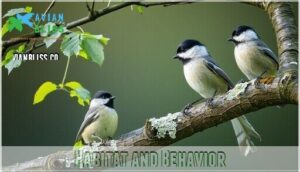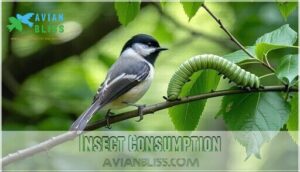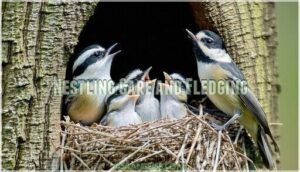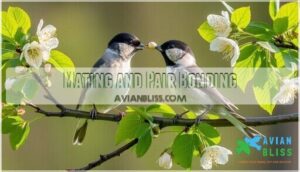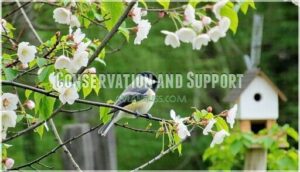This site is supported by our readers. We may earn a commission, at no cost to you, if you purchase through links.
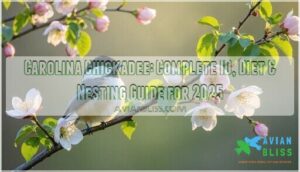
These birds call southern woodlands home, snacking on insects, seeds, and berries. You’ll hear their “chick-a-dee-dee” call before you see them.
They nest in tree cavities, often using old woodpecker holes, and fiercely protect their young. The Carolina Chickadee’s social nature and clever foraging make it a backyard favorite.
Stick around, and you’ll find out how to make your yard a chickadee haven.
Table Of Contents
- Key Takeaways
- Carolina Chickadee Basics
- Habitat and Behavior
- Diet and Foraging
- Nesting and Breeding
- Conservation and Support
- Frequently Asked Questions (FAQs)
- Where do Carolina chickadees live?
- What does the Carolina Chickadee sound like?
- Do Carolina chickadees use birdhouses?
- Where are Carolina Chickadees found?
- What is the difference between a black cat chickadee and a Carolina Chickadee?
- Are Carolina Chickadees endangered?
- Do Carolina Chickadees use nest boxes?
- What is the lifespan of Carolina chickadees?
- How do Carolina chickadees communicate?
- When do Carolina chickadees form pairs?
- Conclusion
Key Takeaways
- You can spot Carolina Chickadees by their black cap, white cheeks, and gray wings, and hear their “chick-a-dee-dee” call before you see them.
- You’ll find them in woodlands, parks, and backyards, where they nest in tree cavities or nest boxes and form tight social flocks.
- You can help them thrive by planting native shrubs, offering nest boxes with 1⅛-inch entrance holes, and avoiding pesticides in your yard.
- You’ll support their year-round diet by providing seeds, berries, and suet at feeders, especially in winter when insects are scarce.
Carolina Chickadee Basics
You’ll quickly recognize Carolina Chickadees by their black cap and bib paired with white cheeks and gray wings.
These tiny birds measure just 4-5 inches long and weigh less than half an ounce, making them smaller than their Black-capped cousins.
Physical Characteristics
You’ll recognize a Carolina chickadee by its compact, spherical body shape and distinctive black cap with matching bib.
These tiny birds measure just 4-5 inches long and weigh under half an ounce.
Their color pattern features crisp white cheek patches contrasting against gray wings and back, plus white underparts with buffy sides.
The neat bib shape and plain gray wing plumage help distinguish them from similar species, making the Carolina chickadee easily identifiable.
Identification Tips
You’ll spot a carolina chickadee by its distinctive black cap and bib paired with bright white cheeks.
Key markings include gray wings without white edging and a neat bib border. Listen for their classic "chick-a-dee-dee" vocalizations during birdwatching.
Similar species like Black-capped Chickadees show more white on wings. Seasonal plumage remains consistent year-round.
Habitat clues include mixed woodlands and suburban feeders where their size and shape become clear identification markers, aided by their distinctive features.
Size and Weight
You’ll find Carolina Chickadees are true pocket-sized birds, measuring just 3.9-4.7 inches long with a wingspan of 5.9-7.9 inches.
These feathered gems weigh only 0.3-0.4 ounces – lighter than most coins in your pocket.
Here are their key measurements:
- Average Dimensions: Length ranges 4-5 inches, slightly smaller than Black-capped Chickadees
- Weight Variation: Consistent 8-12 grams across seasons with minimal fluctuation
- Sexual Dimorphism: Males and females share identical size measurements and proportions
- Size Comparison: Smaller than White-breasted Nuthatches but larger than most warblers
Habitat and Behavior
You’ll find Carolina Chickadees in deciduous and mixed woodlands, parks, and suburban areas where they form active social flocks with strict hierarchies.
These acrobatic birds forage by hopping among twigs, hanging upside down, and sometimes hovering to catch insects while maintaining territorial spacing of at least 2-5 feet between individuals.
Preferred Woodlands
Carolina chickadee’s woodland preferences span deciduous woodlands, mixed forests, and forest edges where tree cavities abound.
You’ll discover these adaptable birds thriving in suburban areas and urban parks, demonstrating remarkable regional variations in habitat selection.
Their woodland composition needs include mature trees for nesting and diverse vegetation layers supporting insect populations throughout seasons.
Social Interactions
You’ll find these chickadees aren’t loners.
Even in winter, Carolina chickadees stick together, forming lively flocks with clear pecking orders.
Winter flocking creates tight bird communities with strict flock hierarchy – dominant birds get prime feeding spots.
Each carolina chickadee maintains territorial spacing of 2-5 feet, using "gargle" alarm calls during aggressive encounters.
Mixed flocking with nuthatches and woodpeckers offers safety in numbers.
Their social behavior centers on rank-based chickadee flocks that determine nesting success come spring.
Flocking behavior provides increased awareness of predators and is a key aspect of their social behavior.
Foraging Techniques
Three techniques define chickadee foraging behavior.
Gleaning involves picking insects from bark crevices and leaf surfaces.
These acrobatic birds excel at hovering beneath branches to snatch flying insects mid-air.
Caching food becomes essential during winter months when their insect diet shifts toward seeds and berries at backyard feeders.
They are very acrobatic birds.
Nesting Sites
Carolina chickadees typically select tree cavities between 4-14 feet above ground for their nesting sites.
These cavity nesting birds prefer soft or rotten wood that they can easily excavate together over 7-10 days.
They’ll also use abandoned woodpecker holes, natural cavities, or nesting boxes with proper entrance holes for their chickadee habitat needs.
Consider pre-made nesting boxes for chickadees, providing them with a suitable chickadee habitat.
Diet and Foraging
Carolina chickadees adapt their diet throughout the year to meet their energy needs.
These active birds consume mostly insects during warm months but shift to seeds and berries when winter arrives.
Insect Consumption
During warm months, caterpillars become your carolina chickadee’s primary protein source.
These tiny acrobats consume up to 90% invertebrates while raising nestlings, making caterpillar importance vital for breeding success.
Insecticide impact devastates their food supply, affecting nestling diet quality and survival rates.
Bluebirds also thrive when provided protein rich mealworms.
Key insect consumption patterns:
- Caterpillars – Make up majority of nestling diet during breeding season
- Moths and beetles – Provide essential proteins for adult energy needs
- Aphids and spiders – Supplement daily foraging strategies throughout spring
- Flying insects – Caught mid-air using specialized sallying techniques
Seed and Berry Diet
Alongside insects, these birds love seeds and berries.
They’ll visit bird feeders for sunflower seeds, peanut chips, and suet.
Native seeds and bird berries like dogwood or holly boost the chickadee diet with essential nutrients.
If you want to help, offer a mix of bird seeds and Winter Berries. This supports their Seed Preferences and Nutritional Value needs.
Winter Food Sources
During winter months, you’ll notice Carolina chickadees shift their diet dramatically. Plant matter increases to roughly 50% of their intake as insects become scarce.
These adaptable birds rely heavily on cached food they’ve stored throughout autumn.
Top 5 Winter Food Sources for Carolina Chickadees:
- Suet Benefits – High-fat suet provides essential calories for cold weather survival
- Seed Preferences – Sunflower seeds, peanut chips, and safflower seeds dominate feeder visits
- Berry Availability – Native berries from elderberry, sumac, and poison ivy sustain them
- Caching Behavior – Previously stored insects, seeds, and nuts become critical reserves
- Feeder Competition – Multiple feeder stations reduce competition with larger birds
Carolina chickadees demonstrate remarkable food storage abilities. They’ll hide thousands of food items in bark crevices and retrieve them weeks later.
Supplementing their diet with high-fat suet cakes can be very beneficial. Bird feeders become lifelines during harsh weather when natural food sources freeze or disappear under snow.
Pesticide Sensitivity
Your carolina chickadee faces serious threats from pesticide exposure that directly impact their survival.
These tiny birds show higher sensitivity to organophosphates and carbamates than mammals due to slower metabolic processes.
The widespread use of pesticides can lead to significant wildlife mortality, especially among bird populations.
| Pesticide Type | Impact on Chickadees |
|---|---|
| Organophosphates | Nervous system damage, reduced reproduction |
| Carbamates | Muscle weakness, impaired foraging ability |
| Neonicotinoids | Colony collapse, navigation problems |
| Herbicides | Eliminates insect food sources |
Chickadee decline accelerates when you use conventional lawn treatments.
Safe gardening with organic solutions protects these essential insect controllers while maintaining your yard’s health.
Nesting and Breeding
You’ll find Carolina Chickadees fascinating during their spring breeding season when pairs work together to create the perfect nesting environment.
These devoted birds typically form lifelong partnerships and demonstrate remarkable dedication to raising their young through careful nest construction and attentive parental care, showing remarkable dedication.
Nest Construction
Carolina chickadees are skilled architects who build their cozy homes in tree cavities.
Masters of home design, these tiny birds turn tree cavities into snug, welcoming nests for their families.
They’ll spend 7-10 days excavating their perfect cavity, creating dimensions roughly 5 inches deep.
These resourceful birds also happily use abandoned woodpecker cavities or nest boxes with 1⅛-inch entrance holes for their Carolina chickadee families, selecting spots in soft or rotting wood, often 4-14 feet above ground.
Egg Laying and Incubation
After completing their nest, female Carolina chickadees begin laying their clutch of eggs with remarkable precision.
The timing connects directly to successful incubation and hatching success for these devoted parents.
- Clutch Size: Females typically lay 5-8 jelly bean-sized eggs, with 6 being most common
- Egg Coloration: White to creamy-white eggs feature reddish-brown spots concentrated on the broader end
- Incubation Period: Female-only incubation lasts 12-15 days, averaging 13 days for ideal development
Nestling Care and Fledging
Once eggs hatch, bird parents work nonstop, bringing insects and seeds for Parental Feeding.
Nestling Development moves quickly—Carolina chickadee nestlings grow fast, stretching wings and learning to beg.
Around day 16, Fledgling Independence begins as they leave nests.
Nest architecture is carefully designed to protect developing eggs and nestlings.
Post-Fledging Care continues, with parents guiding young in finding food.
This teamwork boosts Brood Survival.
| Stage | Parent Role | Nestling Change |
|---|---|---|
| Feeding | Brings food | Rapid growth |
| Cleaning | Removes waste | Stays in nest |
| Guarding | Alerts to danger | Learns to beg |
| Fledging | Encourages flight | Leaves nest |
| Guiding | Teaches foraging | Gains independence |
Mating and Pair Bonding
You’ll discover these birds form lifelong partners during fall pairings within winter flocks.
Carolina chickadee pairs show remarkable nesting fidelity, with dominant birds claiming prime territories first.
Mate selection involves courtship feeding and vocal displays.
While most pairs remain together for years, breeding success varies by region – Texas populations show nearly 100% annual pair retention versus 50% in Tennessee.
This strong bonding improves nesting habits and chick survival rates.
Their survival is aided by dropping body temperatures to conserve energy.
Conservation and Support
You can help Carolina Chickadees by planting native shrubs, putting up nest boxes, and avoiding pesticides.
These steps protect their food and nesting sites so the birds can thrive in your area.
Native Plant Support
After nestlings leave the cavity, your yard can help them thrive.
Aim for at least 70% native plants, including berry-producing shrubs, seed-bearing plants, and insect-attracting native trees.
These support the Carolina chickadee’s diet and nesting needs.
Birdfriendly gardening boosts bird conservation and habitat enrichment, turning your space from a food desert into a bird habitat conservation haven.
Consider planting native berry shrubs to further support local wildlife.
Nest Box Usage
After planting native shrubs, you’ll want to help carolina chickadees by setting up a nest box. Place your box 5–15 feet up, near woods or edges—just like natural woodpecker cavities.
Use natural Box Materials like cedar. To further enhance the nest box, consider optimal height and orientation for chickadees.
Add Predator Guards to keep bird nests safe. Regular Box Maintenance, like weekly checks, matches chickadee preferences and boosts nesting success.
Pesticide Avoidance
Pesticides can turn your garden into a danger zone for Carolina chickadee health.
Try these birdfriendly practices:
- Choose Pesticide Alternatives and Safe Insecticides.
- Practice Organic Gardening for healthier garden ecosystems.
Avoid neonicotinoids and pyrethroids, and support bird conservation by skipping chemical sprays.
Regularly check for natural pest solutions—these bird conservation strategies protect both birds and bugs.
Protecting Food Sources
Keeping food sources healthy goes hand in hand with avoiding pesticides.
Give Carolina chickadees a boost by planting native shrubs and supporting insect diversity. Winter feeding with bird seeds and berries, plus steady water sources, helps them thrive.
Organic gardening keeps bird insects safe, while leaving brush or dead wood provides natural foraging. These bird conservation strategies build stronger backyard flocks, and by doing so, you support native shrubs and bird conservation.
Frequently Asked Questions (FAQs)
Where do Carolina chickadees live?
You’ll find these birds in deciduous and mixed woodlands, swamps, and even your backyard.
They love parks, gardens, and suburban areas, often flitting through trees or visiting feeders, always keeping a close-knit social circle.
What does the Carolina Chickadee sound like?
You’ll hear a sharp “chick-a-dee-dee-dee” call, often used as an alarm.
Their song is a clear, whistled “fee-bee fee-bay.”
These sounds help the birds stay in touch and warn about predators.
Do Carolina chickadees use birdhouses?
Unlike some picky birds, you’ll see these tiny acrobats happily using birdhouses, especially if the entrance hole is about 1 ⅛ inches wide.
Place the box 5–15 feet up, near trees or shrubs for best results.
Where are Carolina Chickadees found?
You’ll spot these tiny birds across the southeastern and central United States, from New Jersey to Texas.
They love woodlands, parks, and gardens, often hopping through trees or visiting backyard feeders in suburban neighborhoods.
What is the difference between a black cat chickadee and a Carolina Chickadee?
Don’t judge a book by its cover—black-capped and Carolina Chickadees look almost identical.
You’ll notice Carolina Chickadees have plainer gray wings, a neater black bib, and duller white cheeks.
Their songs and calls also differ subtly, making them distinguishable by their unique vocalizations, particularly the difference in their tunes.
Are Carolina Chickadees endangered?
You don’t need to worry—Carolina Chickadees aren’t endangered.
They’re common in their range, thriving in woodlands and suburbs.
Just keep those feeders full and gardens pesticide-free, and you’ll keep seeing these little acrobats around.
Do Carolina Chickadees use nest boxes?
You can attract these birds by installing a nest box with a 1 1/8-inch entrance hole.
Place it 5–15 feet above ground, add some wood shavings, and they’ll often move right in for nesting season.
They will likely be attracted to the nest box and use it for their needs.
What is the lifespan of Carolina chickadees?
Think of life as a winding path—Carolina chickadees usually walk it for about 2–3 years in the wild.
With luck and shelter, some can reach 4–5 years, though most face many natural dangers.
How do Carolina chickadees communicate?
You’ll hear them use “chick-a-dee-dee” calls to warn about predators and soft whistles to keep in touch with their flock.
They also use gargle calls during squabbles, keeping their social order clear and communication strong.
When do Carolina chickadees form pairs?
Like clockwork in the fall, you’ll see these small birds start pairing up.
They form bonds as the leaves drop, then stick together through winter, ready to claim a nesting territory by late winter.
Conclusion
Many believe the Carolina Chickadee is hard to spot, but with the right knowledge, you can find them easily.
Look for their black cap, white cheeks, and listen for their call.
They live in wooded areas, use tree cavities for nests, and eat insects, seeds, and berries.
Avoid pesticides, use native plants, and add nest boxes to help them thrive.
By understanding the Carolina Chickadee’s habits, you’ll make your yard a true haven for this bird.

